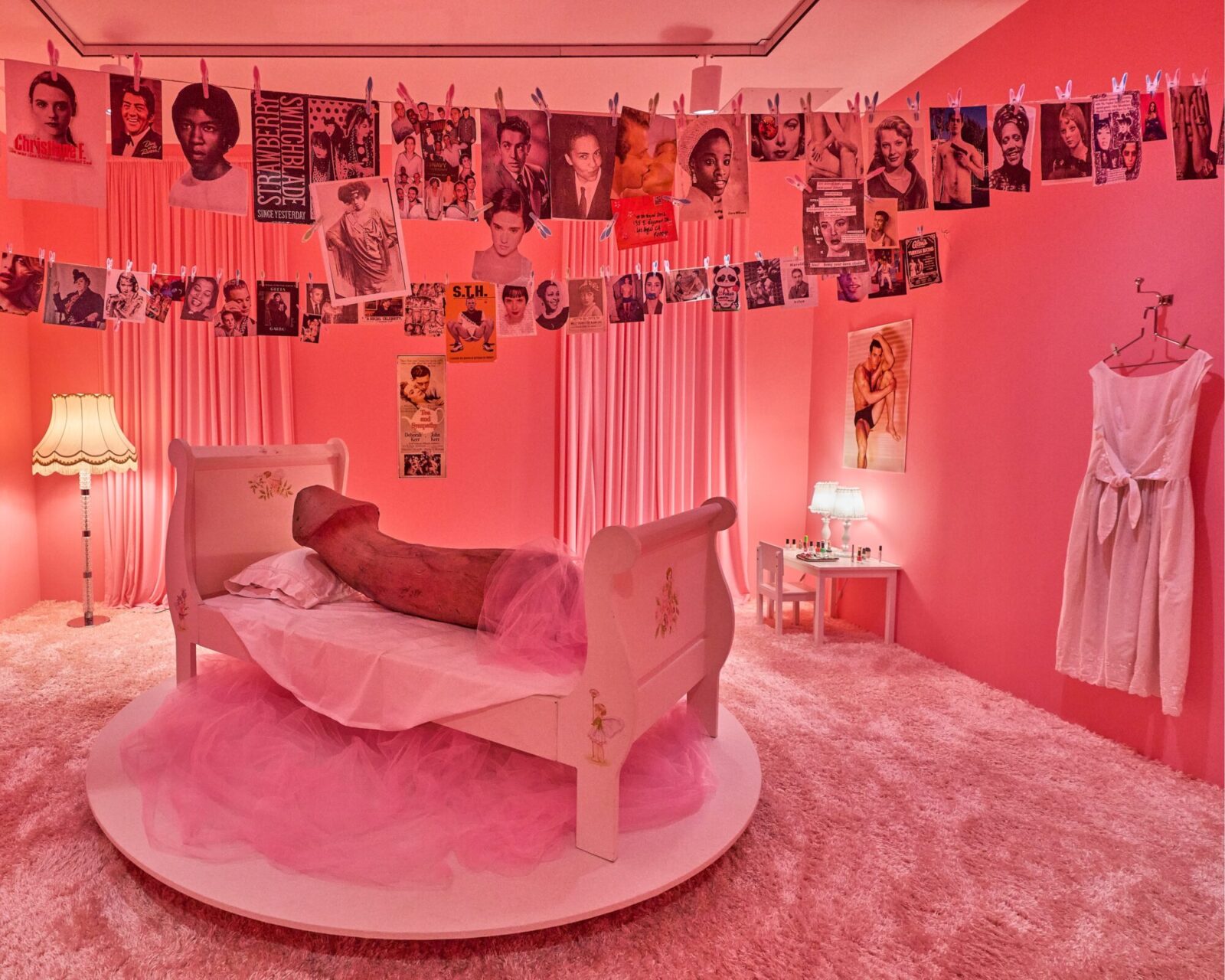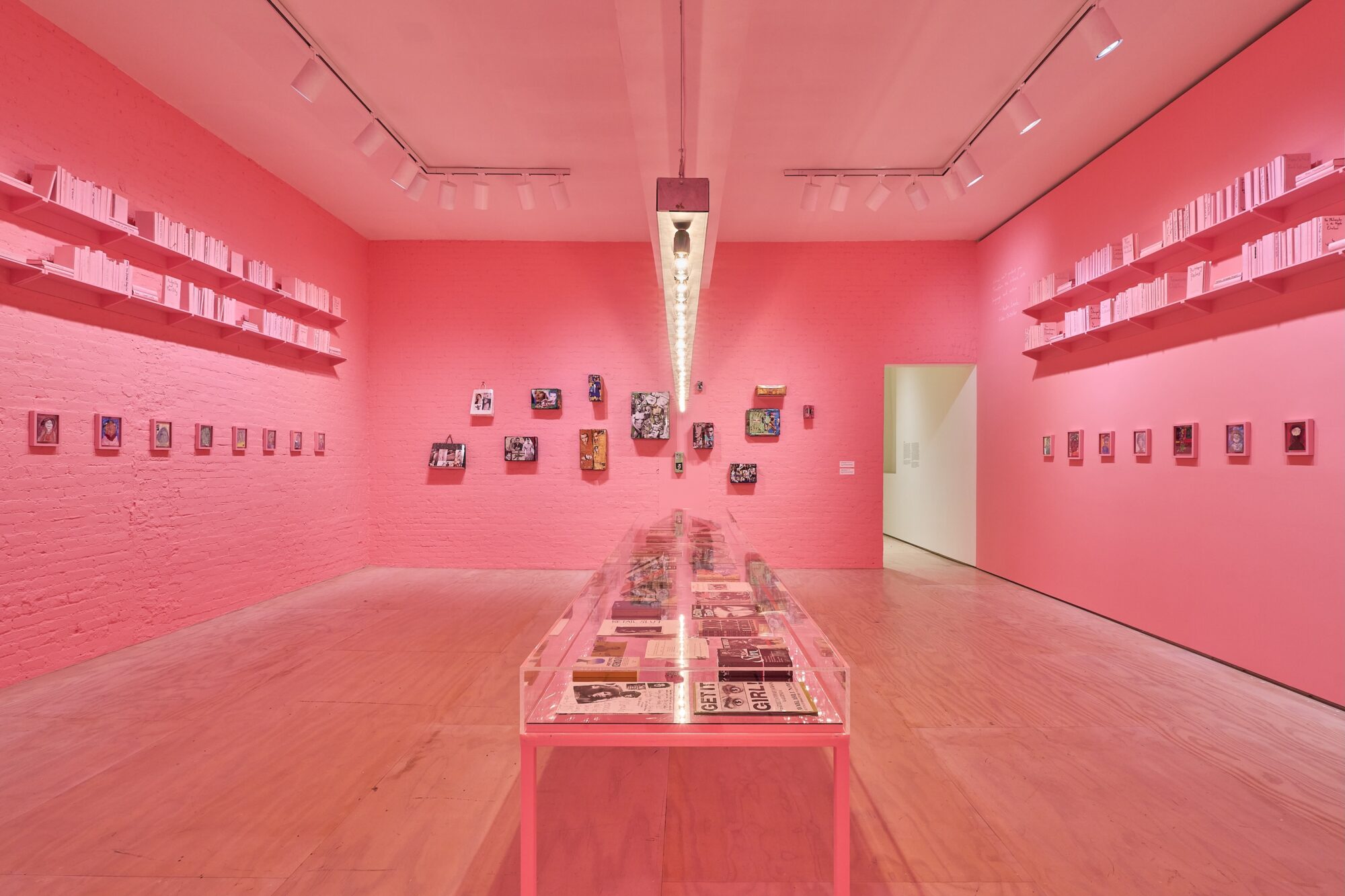Giving the Finger to the Trappings of Genre: ‘Vaginal Davis: Magnificent Product’

A show that first appeared at the Moderna Museet in Stockholm (2004), Vaginal Davis: Magnificent Product, spans five decades of the art practice of performer, musician, filmmaker, writer, visual artist, and educator Vaginal (Crème) Davis. The exhibition is comprised of video, staged installations, visual art, sound work, zines, and sculpture, a testament to Ms.—or Dr., as she sometimes calls herself to emphasize her drag persona—Davis’s commitment to giving the finger to the trappings of genre. It seems her aim all along was not to necessarily take up the individuation of “the artist” as spectacle, but to make art that was so revelatory of who we are and what we could be that it required—demanded—center stage. Through her rigor and commitment to ingenuity, viewers are enveloped with the means of artistic singularity to the ends of art communitas. Vaginal Davis: Magnificent Product not only takes revisionist histories head on—histories that hope to delimit and minimize her contributions to art and music “scenes”—but gives Davis her flowers while she’s still alive to smell them.

Upon arrival, visitors are greeted with the all-seeing eyes of Davis, which lure us through the translucence of its graphic decaling across double doors. Immediately, we are tethered to the play and silliness of the exhibition, which is not to be confused for inconsequential farce. Naked on my Ozgoad: Fausthaus – Anal Deep Throat is an interpretation of the canonical L. Frank Baum’s Oz books and is inspired by her first visual art exhibition at Pio Pico Library in Los Angeles, at the darling age of eight. The characters in the queer world of Oz are cast in aluminum, with low hanging lamp fixtures illuminating each piece and fluorescent white walls are gussied up with the direct application of makeup on illustrations of characters. Front in center in Naked on my Ozgoad is Davis’s most recently published zine, Middle Sex. It plays with the scared/secular divide down to its form, which appropriates the pocket bible, including a long black book ribbon.
Davis credits the start of her art practice to her mother, Maria Magdalena DuPlantier. In 1944, DuPlantier migrated from Louisiana to the West Coast of the United States to accompany her family, who had already migrated during the first wave of the Great Migration. I must confess, growing up black in Southern California, it’s easy to feel a recurring ambivalence surrounding the nexus of one’s racial, gender, and sexual place. It’s not so much about who you know yourself to be as a young black person, but what spaces your body can safely traverse. The imposition of cultural homogenization is quite palpable, despite the promise of the golden state: multiracial harmony in its purest form. Raised between the Jordan Downs projects in Watts and the Ramona Gardens Projects in East LA, Davis deftly navigated the trap of anti-Blackness and the gender/sexuality norms of LaLa Land.

In conversation with Lewis Church for PAJ: A Journal of Performance and Art (2016), Davis described Los Angeles in the following way:
“L.A. is a very unique city. Only a place like L.A. could produce a Ron Athey, a Vaginal Davis, a Kembra Pfahler, a Beck. Only L.A. can produce that kind of weirdness, that uniqueness, because L.A. itself is this very, very strange, strange city. If you haven’t been there yet then it’s hard to try to articulate just how strange and how different it is. It’s an industry town. I call it the ‘Entertainment Industrial Complex’ city. Because of that it isn’t a city where art is always cherished, especially the kind of art that I do, because it’s not commercial enough and it doesn’t make money. Only the commercial arts, like film, television, and popular music are given real attention. I went against the grain of those commercial practices from an early age. I started doing little writing projects and art when I was still a child, and getting attention from it. Ofcourse at that time my elders wanted to guide me in a certain way that was more commercial, like being an actor. I rejected that from the get-go.”
The backdrop of Hollywood and their distant hills—idyllic in their furl and roll—was the perfect place for Davis to start making and creating in the 1980s. A self-trained scholar of Hollywood cinema and television, her deep knowledge of media became the fodder for much of her work. Using Hollywood and its sublimation in much of her work, she’s been able to reveal how adeptly its commercial interests touch every part of our lives. Using the avatar of the “Blacktress,” she turns what is manufactured as perfect and idyllic and transforms it into to effortless erotic glamour. Fuck the horror of the niminy-piminy types. For Davis, what is the beauty of living without illicit play?
In his 1997 essay, “‘The White to Be Angry’: Vaginal Davis’s Terrorist Drag,” José Esteban Muñoz characterized Dr. Davis’s performance as “fantastic and farcical.” Indeed, it is. Pretty-pretty pink washes The Wicked Pavilion: Tween Bedroom (2021). The room is daftly curated out of the evidently personal ephemera. Sharon Gault’s papier-mâché penis (1977) is nestled in a Victorian children’s bed and served on “Lazy Susan” platform. Its curvature is as sumptuous, as it is hilarious. Tucked in the corner of the room, a miniature vanity—lit by cutesy twin lamps donned with romantic coquette ruffled lace—glows goldenly to illuminate tween beauty essentials like Maybelline Great Lash Mascara and a kaleidoscope of nail polish bottles. This is the apex of resourcefulness, meeting high camp. To occupy the category of the ‘tween’ is to obsess over that which seems nonsensical to adults, but Ms. Davis uses this fertile ground to make a cosmograph of her inspiration as it meets radical art praxis. A clothesline cutting across the room is constituted out of various objects: event invitations from the Afro Sisters (1983—1984); photo portraits of icons like Audre Lorde and Dean Martin, and the LP single of Strawberry Switchblade’s synth-bop “Since Yesterday” (1984).


Her reverence for black, queer, feminist icons is carried into The Wicked Pavilion: The Fantasia Library (2021), which features issues of Fertile La Toyah Jackson and works from black women literary titans like Sonia Sanchez (Homegirls & Handgrenades, 1984), Octavia Butler (Kindred, 1979), and Nella Larson (Quicksand, 1928). Davis’s admiration for these writers extends by way of small-scale portraitures, abstractly painted and includes black musical icons, like Minnie Riperton and Teena Marie. Combined, The Wicked Pavilion: Tween Bedroom (2021) and The Wicked Pavilion: The Fantasia Library (2021) leans into the black, queer, and feminine tendrils of the grandeur. ‘Pink’ in this context is used to expose us to the delights of femininity, yet sidesteps its construction as prim perfection, found its noun and adjective forms. What is sustained through weaponry is made into a whimsy balm.
Screened in The Carla DuPlantier Cinerama Dome (Carla, thank you for introducing your cousin to punk music) That Fertile Latoya Feeling (1983) chronicles Fertile Latoya Jackson’s delivery of “eleven-tuplets” on the living room carpet of her twink boyfriend’s apartment. The uproarious short leaves very few details to chance. Blue azure eyeshadow hams up Fertile and Vaginal’s performance, their eyes giving away the fun of it all, even though the underbelly of the film is a critique of the medical industrial complex: Dr. Davis has to deliver Jackson’s baby because she doesn’t have health insurance. When Jackson skates to disco music in a vacant parking lot immediately after giving birth, laughs rupture the imposed silence of the museum setting. This moment captures the essence of Vaginal Davis: Magnificent Product: a playful and fanciful wonderland that showcases the vital importance of Davis’s analog work in a trenchantly digital world.
In 2005, Davis was gentrified out of her home of Los Angeles and moved to Berlin, where she continued her collaborative art-making practice with the artist collective CHEAP. The lower level of MoMA PS1 features their 2024 multimedia instillation, Choose Mutation (2004/2025), which contains projected video and photographs taken by Annette Frick, documenting the members of the collective during their early performances. The use of black and white motifs across photos that panel the wall, contrast the photo sensitivity of the experimental video, which extends the theme of play to remark on the embodied effects of social and political control.

Extending the centrality of sound to Davis’s practice, the playlist for the exhibition is a sonic odyssey of great proportions. Tethering the listener to the shock and awe of a queer punk art world in 1980s, 1990s southern California, it assumedly captures her distinct taste in music. The desolate drive of The Nymphs, “Sad and Damned” sharply departs from the show tune-esque vivacity of Rufus Wainwright’s “Beauty Mark,” which the playlist begins with. Tracks like the post-riot grrl anthem “Hot Topic” names queer feminist icons including Vaginal Davis and subtends the fury found in 7 Year Bitch’s “The Scratch.” Much like the work that comprises her oeuvre, the playlist takes up the rebellious spirit of her many conglomerates and co-conspirators: Cholita! The Female Menudo, Black Fag, Pedro, Muriel, and Esther, Ron Athey, José Esteban Muñoz, Jennifer Doyle, Steve Albini, to name a few.
What makes for the greatness of an artist like Vaginal Davis is her insistence on collaboration. While the organicism of said collaboration most likely can’t be duplicated in these times, it’s a much-needed reminder that we desperately need each other in order to survive the rising tides of fascism and the throes death-driving capitalism.
Vaginal Davis: Magnificent Product is on view at MoMA PS1 until March 2, 2026. Special thanks to my comrade Jasmine Wilson for helping me document my visit.
You Might Also Like
Ahead of Whitney Biennial, Ligia Lewis Conjures a “With-ness” for “study now steady”
Holler Rat, a Memoir as a Performance: Christen Clifford Interviews Anya Liftig
What's Your Reaction?
Brittnay L. Proctor is a researcher and writer of performance, popular culture, and sound/visual culture at the nexus of blackness, gender, and sexuality. She is Assistant Professor of Race and Media in the School of Media Studies at The New School (NY, NY) and the author of Minnie Riperton’s Come to My Garden (Bloomsbury Press: 33 1/3 Series). She is currently working on two book projects; one of which soundtrack’s black Southern migration to California during the Second Great Migration and the other, which draws on LP records and Compact Disc’s (CD’s), to trace the sonic and visual discourses of gender and sexuality in funk music.

